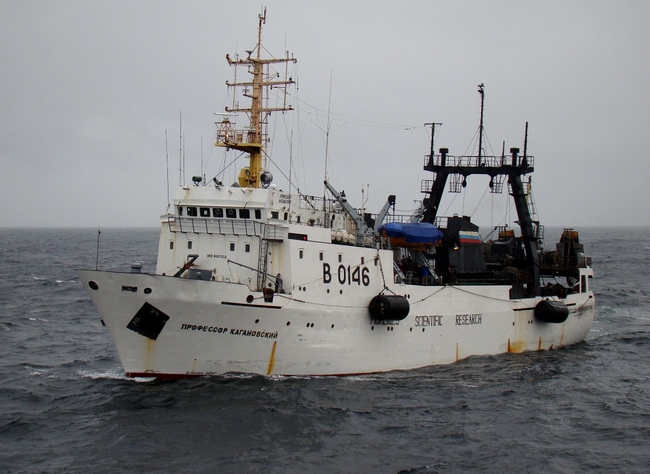Stock assessment
Being the most abundant fish stock in the Russian Far East fisheries, Walleye pollock has a priority attention of fishery science and agencies. According to the Federal Law “On fisheries…” and regulations of the Ministry of Agriculture, Walleye pollock fisheries in the Far East areas are managed with the Total Allowable Catch (TAC) which is based on comprehensive stock assessment, monitoring, and review process.
Stock assessment survey parameters are determined in “Complex Fisheries Research Program in the Far Eastern Basin” which is approved by the Federal Fisheries Agency and coordinated by VNIRO. The Program specifies individual sub-programs on pollock stocks research expeditions and monitoring for the Far East fishery institutes (TINRO, KamchatNIRO, SakhalinNIRO, MagadanNIRO). The stock assessment surveys in the Bering Sea areas are held in cooperation with the US scientists.
Annually, Far East institutes conduct 12-15 expeditions on research vessels to cover all areas of Walleye pollock distribution within the Far East waters.Stock assessment survey parameters are determined in “Complex Fisheries Research Program in the Far Eastern Basin” which is approved by the Federal Fisheries Agency and coordinated by VNIRO. The Program specifies individual sub-programs on pollock stocks research expeditions and monitoring for the Far East fishery institutes (TINRO, KamchatNIRO, SakhalinNIRO, MagadanNIRO). The stock assessment surveys in the Bering Sea areas are held in cooperation with the US scientists.
Fisheries Scientific Research vessel “Professor Kaganovsky” (TINRO-Center)
The abundance and biomass of Walleye Pollock are estimated by trawling, ichthyoplankton-trawling and acoustic surveys (with adaptive and basic technology) conducted on annual base since 1983. Surveys provide comprehensive and accurate data about spawning and commercial stocks, its reproductive status, recruitment, productivity, and population dynamics of Walleye Pollock in the Russian EEZ.
Moreover, through these surveys environmental information on natural habitat condition of Walleye Pollock, sustainability of surrounding pelagic communities and feeding resources are obtained.
The bottom trawl surveys are regularly held during summer-fall season in the different regions of the Sea of Okhotsk (near the coastal area of Kamchatka peninsula) and in the western part of the Bering Sea. Bottom trawl surveys are primary aimed at stock assessment of benthic fish species (e.g. flatfish, cod, saffron cod, etc.) and invertebrates (crabs), but also provide additional data used in pollock stock assessment.
Fish egg survey, one more survey of stock assessment process, is conducted on annual base, and studies mature fish productivity, perspective recruitment and its abundance within a population by analysis of data on developing embryos and further estimation of spawning stock.
Recently, stock modeling has become a mandatory procedure in Walleye Pollock stock assessment process. Russian scientists use several stock assessment models (e.g. Syntes, TISVPA) depending on a specific stock and available input data.
Pollock fisheries are also monitored by scientific observers working on commercial trawlers harvesting pollock during all fishing seasons and areas. Observers from fishery research institutes collect accurate biological data on catches, size and age composition, juvenile by-catch, etc. which is used in stock assessment modeling for TAC determination.
More information:
Methods of Walleye Pollock stock assessment in the Okhotsk and Bering Seas, annual stock research activities and justification of total allowable catches. FFA website.
TAC determination and setting procedure. FFA website
More scientific references:
Babayan V.K. Precautionary approach to the assessment of the total allowable catch (TAC). – VNIRO, 2000. (In Russian)
Bulatov O.A. On the question of the methodology of stock forecasting and harvest strategy of pollock fishery // Tr. VNIRO. 2015. Vol. 157. Pp. 45-70. (In Russian)
Balykin P.A., Varkentin A.I. Data interpretation ichthyoplankton surveys to assess the spawning stock of pollock // Methodical aspects of studies of fish of the seas of the Far East: M.: VNIRO. 2006. Vol. 146. pp 159-165. (In Russian)
Ilyin O.I., Sergeeva N.P. and Varkentin A.I. East-Kamchatka Walleye Pollock (Theragra chalcogramma) Stock and TAC Assessment Based on the Precautionary Approach // Tr. VNIRO. 2014. Vol. 151. (In Russian)
Smirnov A.V., Avdeev G.V., Nikolaev A.V. and Shevtsov V.I. On the estimation of stocks of Okhotsk pollock by instrumental methods // Tr. VNIRO. 2006. Vol. 146. Pp. 132-152. (In Russian)
